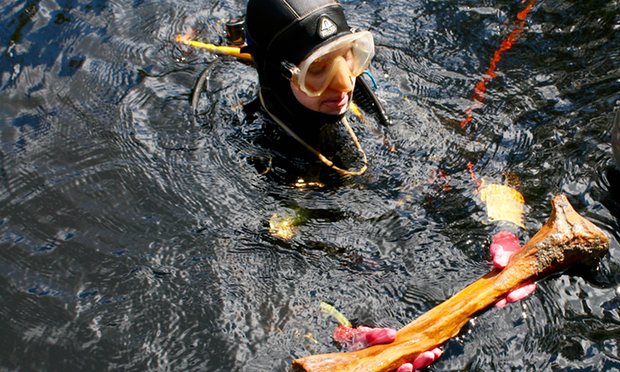It looks like you're using an Ad Blocker.
Please white-list or disable AboveTopSecret.com in your ad-blocking tool.
Thank you.
Some features of ATS will be disabled while you continue to use an ad-blocker.
3
share:
Discovery Points to Earlier Arrival of First Americans
Continued...
I've followed the Clovis Theory/land bridge migration before but this seems to dismiss it, either way fascinating so far.
 - From YouTube Florida State video shared below at 1:04
- From YouTube Florida State video shared below at 1:04
Discovery Points to Earlier Arrival of First Americans
Also see,
Sinkhole discovery suggests humans were in Florida 14,500 years ago

Continued...
Sinkhole discovery suggests humans were in Florida 14,500 years ago
Then it may be possible the first Americans were in other locations of the Americans even earlier.
See the following video for more of what was found:
Florida archaeological site yields clues to early civilization in southeast U.S.
Haven't seen this posted yet but there's quite a few sources now since it was released. Apologies as I'm having a few issues with my browser.
Thoughts?
A stone knife, mastodon bones and fossilized dung found in an underwater sinkhole show that humans lived in north Florida about 14,500 years ago, according to new research that suggests the colonization of the Americas was far more complex than originally believed.
Continued...
More than 14,500 years ago, a spring-fed pond served as an important water source for mastodons and the early Americans who hunted them. The site is now submerged beneath northern Florida's Aucilla River. A thousand years before big game hunters who used what are known as Clovis spearpoints spread across North America, earlier arrivals were living near Florida’s Aucilla River alongside mastodon and other animals now long extinct. So say archaeologists who spent four years investigating an underwater sinkhole known as the Page-Ladson site, located in northern Florida east of Tallahassee.
I've followed the Clovis Theory/land bridge migration before but this seems to dismiss it, either way fascinating so far.

A “bifacial” stone knife—one with a blade chipped to sharpness on both edges—and other stone artifacts found in riverbed sediment dated to 14,550 years ago provide “unequivocal” evidence of human habitation, says one of the principal investigators, Michael Waters of Texas A&M University. The researchers’ findings were reported Friday in the journal Science Advances. Picture of mastodon tusk Enlarge A mastodon tusk discovered in a sinkhole in the Aucilla River shows clear signs of human contact, according to a new analysis.
Discovery Points to Earlier Arrival of First Americans
Also see,
Sinkhole discovery suggests humans were in Florida 14,500 years ago

“So the ice-free corridor is not our answer for how the Americas were initially colonized,” she told the Smithsonian. “The logical way people could have come to Florida by 14,600 years ago is if their ancestors entered the Americas by boat along the Pacific Coast,” Waters told Discovery News.
“They could have traveled by boat to central Mexico, crossed and come along the Gulf Coast. They could have entered the Americas via the Columbia river and then traveled inland to the Mississippi river and followed it down and entered the Gulf Coast, eventually making their way to Florida.”
Continued...
Several anthropologists not affiliated with the research said it added to the mounting evidence of a complex, many-staged migration into the Americas.
“I think this paper is a triumph for underwater archaeology and yet another nail in the coffin of the Clovis-first theory,” Jon Erlandson, an anthropologist at the University of Oregon in Eugene, told Nature magazine.
Sinkhole discovery suggests humans were in Florida 14,500 years ago
Then it may be possible the first Americans were in other locations of the Americans even earlier.
See the following video for more of what was found:
Florida archaeological site yields clues to early civilization in southeast U.S.
Haven't seen this posted yet but there's quite a few sources now since it was released. Apologies as I'm having a few issues with my browser.
Thoughts?
That would be interesting. I have read about the clovis era, mostly from Mr. Fenn and the "fenn clovis collection".
I know the last of the mastadons were finally killed off in the Michigan LP.
I know the last of the mastadons were finally killed off in the Michigan LP.
please add further discussio to the below thread:
Thread closed.
originally posted by: Phage
a reply to: dreamingawake
Yeah.
www.abovetopsecret.com...
Thread closed.
new topics
-
To become president, Zelensky had to learn Ukrainian
Political Conspiracies: 3 hours ago -
Green Grapes
General Chit Chat: 7 hours ago
top topics
-
Joe meant what he said about Hunter's pardon....
US Political Madness: 16 hours ago, 13 flags -
S.C. Jack Smith's Final Report Says Trump Leads a Major Conspiratorial Criminal Organization!.
Political Conspiracies: 14 hours ago, 11 flags -
Advice for any young Adult .
General Chit Chat: 15 hours ago, 10 flags -
Green Grapes
General Chit Chat: 7 hours ago, 6 flags -
To become president, Zelensky had to learn Ukrainian
Political Conspiracies: 3 hours ago, 5 flags -
Regent Street in #London has been evacuated due to a “bomb threat.”
Other Current Events: 17 hours ago, 3 flags -
Those Great Fresh Pet Commercials
Television: 12 hours ago, 3 flags
3
